The Million Dollar Question is: How can we make it easier for our children to cooperate the first time we ask and to make it harder for them to forget or to ignore us or to argue back? Wouldn’t it be great if there were a technique that would help our children understand what they need to do, remember what they need to do, and actually do what they need to do, without reminders? A simple tool called a “think-through” is the key to achieving all of these goals.
A think-through maximizes the likelihood of your child cooperating by fixing the expectation or rule firmly in his long-term memory. But it is not a reminder.
When we’re reminding our children about what they should do and how they should do it, have you noticed that they’re usually not listening? When we tell our children what we want them to do, we hope that they take us seriously. But to kids, it sounds like another lecture — blah, blah, blah — and they easily tune us out.
When you use a think-through, it is not you but your child who is saying what he has to do. That shift has a powerful, positive impact on his memory and on his willingness to do it. Think-throughs are a highly effective technique for improving any habit. They are different from reminders in two important ways: They happen before the misbehavior occurs, and your child does the talking, not the parents.
How Mozart and Beethoven Can Boost Your Child’s Brain
Here are the basic steps of doing a think-through with your child:
> CHOOSE A NEUTRAL TIME. Never try to do a think-through right after something has gone wrong. You will be annoyed instead of calm and positive, and your child will be resentful and, possibly, rebellious. A neutral time is when neither of you are in a hurry or annoyed. Look at your child and wait, smiling, until you have his full attention.
> ASK, DON’T TELL. Ask your child several leading questions about the behavior you want to see more of. Remember, your child already knows the rule, so don’t repeat it. Phrase your questions so that they cannot be answered with a yes or no.
> YOUR CHILD ANSWERS IN DETAIL, telling you what he should do. The more detailed your child’s response, the more it will stick in his memory, so ask a number of follow-up questions. The only time you would switch from asking to telling is when your child’s answer is incomplete or inaccurate. In that case, clarify what you mean, and ask some more questions, until you are sure your child understands the rule or routine.
Here are some sample think-throughs, so you get the idea:
One mom didn’t want her son, Jamie, to complain about the food he was served, and wanted him seated at the table until he was excused.
Mother: Jamie, I’m going to ask you some questions about dinnertime. Tell me what you have to do at dinner.
Jamie: I have to be good.
Mother: I’m glad you know you have to be good. What will you do when you’re being good?
Jamie: I have to stay in my chair…and not say, “Yuk”?
Mother: You remembered two of our rules. You’re going to stay sitting down for the whole meal until what?
Jamie: Till I’m done.
Mother: No. You have to stay in your chair until Daddy and I say you can be excused. You have to stay until Daddy and I say what?
Jamie: Till you say I can be excused.
Mother: I can see you know that rule now. And why aren’t you going to say, “Yuk”?
Jamie: Because it hurts your feelings?
Mother: That’s right. You don’t want to hurt my feelings. What will you do if you have some food on your plate that you don’t want, instead of saying, “Yuk”?
Jamie: I’ll just leave it, and I won’t say anything horrible.
Mother: That would be polite. That’s what grown-ups do. You’re getting more grown up every day.
No More Socks or Video Games — Try These Unique Gift Ideas for Kids with ADHD!
This think-through took about a minute and resulted in much better (although not perfect) behavior. At dinner over the next few nights, both parents praised Jamie — in other words, they slowed down, noticed, and described in detail a little thing that he did right without using superlatives — for following the two rules that he had a think-through about.
Here’s another example. Let’s say bath time is a problem in your family. Your daughter loves to splash about in the bath, oblivious to the water that is landing on the floor. You can say, “Stop splashing,” but your child is having so much fun that she barely hears your words.
It’s time to get proactive. You will probably need to do daily think-throughs to reduce the problem. Do two or three think-throughs about this every day, long before bath time. Ask the following questions:
> When you’re in the bath, where does the water belong?
> How can you make sure that the floor stays dry?
> What will happen if you keep all the water in the bath?
> If there’s water on the floor, who will mop it up?
> What will you use to mop up the water?
This may seem repetitive, but repetition is necessary if you want to maximize cooperation. Your daughter is doing the repeating. This results in information being stored in her long-term memory. If you were doing the repeating, all that is getting stored in the child’s memory is the thought, “Mom’s a real nag.”
From Calmer, Happier, Easier Parenting, by Noël Janis-Norton. Published by arrangement with PLUME, a member of Penguin Group (USA) Inc. Copyright 2012, Noël Janis-Norton.




